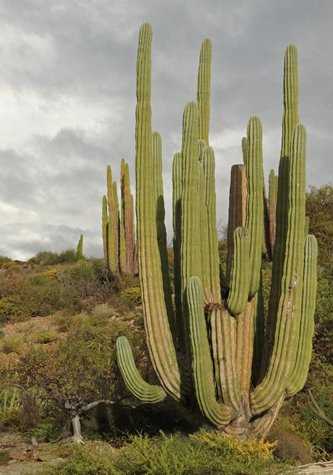Our first morning aboard the National Geographic Sea Bird found us cruising near Isla del Carmen southeast of the town of Loreto. This region is rich in human history. For several hundred years, miners excavated a very pure salt from the island and sold it to Russians in Alaska and to other far away destinations. Loreto was original capital of the state of Baja California Sur and the site of the first successful mission, constructed in 1697 in part from rock obtained from Isla del Carmen.
A blanket of clouds softened the sky and hugged the spine of the Baja Peninsula to the west. The captain spotted a large spout in the distance. Upon closer inspection, it turned out to be a blue whale, the largest animal known. We watched as it rose and then submerged again, displaying a miniscule dorsal fin for such a huge creature. Only about 18% of blue whales studied in the northern hemisphere show their tails when they dive, and it was very lucky for us that this was one of those few. We followed this and then another blue whale, getting excellent looks at their stiff flukes and blue-gray color. Finally it was time to move on. Surprisingly for this desert country, brooding clouds enveloped us and rain began to gently fall. As a real downpour hit, our expedition leader presented an illustrated talk about geology.
Shortly after lunch, a good-sized group of common dolphins approached. It was marvelous to watch their antics as they leapt and slapped their tails. Before long, the anchor dropped offshore from Isla Santa Catalina, one of several islands found within Loreto Bay National Park. This particular spot is distant from the peninsula and because of this isolation, has plants, lizards, and other creatures distinct from those found elsewhere. Our goals for the afternoon included the opportunity to walk within this desert environment and also to enter the underwater world. We donned our masks, snorkels, and wetsuits before slipping into a fascinating environment filled with fish and invertebrates. King angels glided past with bright yellow-orange tails. Schools of greybar grunts swam more quickly, and porcupinefish sculled above the sea stars that clung to the rocks below. For safety, our snorkeling came to a slightly early end due to a lightning storm that hit very close to us.
The rain abated and hikers strode up a sandy canyon on walks of various lengths. Giant barrel cacti, unique to this and a couple of nearby islands, and towering cardon cacti (see photo) rose above thick shrubbery. This vegetation is characterized as Sonoran Desert, similar to that of parts of Arizona. One vigorous group reached the crest of the island, while others invested their time in examining and photographing the landscape in more detail. One of our young, sharp-eyed guests spotted an endemic rattle-less rattlesnake, a very special sighting. As daylight drew to a close and a rainbow rose from the sea, all returned to the ship for a recap of the day’s activities, including some footage taken by our Undersea Specialist, and for a delicious dinner and evening presentation on photography before heading to bed.







